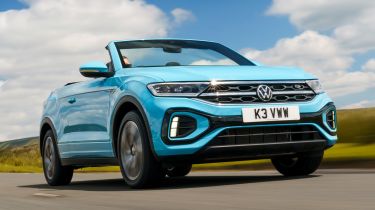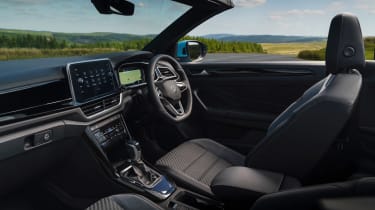Volkswagen T-Roc 1.0 TSI Style Cabriolet review
The open-top Volkswagen T-Roc Cabriolet SUV has been updated for 2022, but it remains a niche choice

Verdict
The updates haven't changed much to the Volkswagen T-Roc Cabriolet experience, so if you were one of the five per cent of T-Roc buyers interested before, then there will still be much to like. It’s not the most engaging or quickest to drive, but the folding roof adds a sense of fun that other SUVs can’t match. If you want to go for this left-field choice, we’d stick with the entry-level model, though - things get pricey higher up the range.
If you’re after a relatively affordable cabriolet, your choices are fairly limited. There’s the Mazda MX-5; brilliant to drive, great to look at, and even cheap to run - but you’re stuck with just the two seats. The MINI Convertible feels fabulously built and has an extra pair of chairs, but they’re not much use to adults. The boot is tiny, too.
If you want an open-top car with some semblance of practicality, then there’s pretty much only one choice. The Volkswagen T-Roc’s crossover body might seem like an unlikely starting point for a drop-top adaptation, but it continues VW’s roofless lineage that dates back 70 years, taking the mantle from the Golf when it launched in 2017.
The popularity has justified its existence, too. While only five per cent of UK T-Roc buyers go for the Cabriolet, in its home market of Germany it took roughly a quarter of the model’s share in 2019.
Used - available now

2022 Volkswagen
T-Roc
42,783 milesAutomaticPetrol1.5L
Cash £18,787
2022 Volkswagen
T-Roc
43,130 milesManualPetrol1.5L
Cash £17,463
2022 Volkswagen
T-Roc
45,937 milesAutomaticPetrol1.5L
Cash £18,500
2025 Volkswagen
T-Roc
20,262 milesAutomaticPetrol1.5L
Cash £23,900Like the rest of the T-Roc family, the open-roofed model has received a series of mid-life updates for 2022. These start with fairly subtle changes to the exterior design; the distinctive D-shaped LED daytime running lights feature on a nose which now gets a revised front grille design. Bolder chrome strips here now make the integration of the headlights to either side more seamless. New colours and wheel options are available, while to the back, the tail light graphics have been subtly reprofiled.
The best - and worst - changes come inside. The perceived quality of the previous T-Roc left us a little disappointed, but the update has reduced the use of hard and scratchy plastics on the dash. The steering wheel feels more modern, and stays just as adjustable as before. However, we’re not fans of the new touch panel for the temperature control; it’s just not as easy to use as the old physical knobs and buttons.
If you’re buying a T-Roc convertible, chances are you’re far more interested in taking it easy and enjoying the fresh air rather than driving with much enthusiasm. Which is lucky, because this isn’t the car for a keen driver. The T-Roc feels a little lazy and nose-heavy through the turns, and over rough roads, there are the telltale signs of scuttle shake as the rear-view mirror shimmies with the rest of the windscreen frame.
A slightly softer ride might have gone some way to mitigating this feeling. However, even on the 17-inch wheels of this car - larger 18-inch items are available from £445 and 19-inchers for £960 - there's a little more fidget and a little less composure than the conventional T-Roc over most surfaces. That’s no surprise, as the conversion from five-door hatch to two-door drop-top adds the best part of 270kg to the overall kerb weight.
So it’s no sports car like the MX-5, but it does share one thing in common with the Mazda: both are commendably stingy when it comes to drinking fuel. The 1.0-litre TSI engine fitted here allowed the T-Roc to get mid-forties mpg in our hands - a figure that would get even better on a long-distance cruise.
It’s an engine that’s well matched to the fairly laid-back nature of the rest of the car, too. With 108bhp and that mass to lug around, the performance is fairly leisurely; 0-62mph takes 12.3 seconds. Once on the move, the decent shove from the 200Nm of torque and well-spaced ratios of the six-speed manual gearbox makes the T-Roc’s performance adequate. A brisker 1.5-litre inline-four turbo is also available, which knocks 2.9 seconds off that acceleration figure - and a seven-speed automatic gearbox is an option.
Though the speed from under the bonnet isn’t the sharpest, the roof is one of the most rapid around. Spot a gap in the clouds, and you can drop the T-Roc’s roof in just nine seconds. It’ll operate at up to 19mph too, so you don’t need to come to a complete stop to work it. Closing is very marginally slower, at 11 seconds. Roof down, the front row occupants are fairly well blocked out from the wind, though a wind deflector, a £315 option which stows away neatly under the boot floor, makes things even calmer. In place, it takes up the space where the back seats go, however.
If you need to make the most of the rear bench, then the T-Roc easily has the MX-5 and the MINI Convertible beaten for practicality. While there’s less room than the T-Roc SUV - and only space for two instead of three - there’s similar knee room to a slightly smaller crossover like the T-Cross and plenty of foot space beneath the front seats. Headroom ranges from fine with the roof up to infinite with it down. Even the 284-litre boot is a reasonable size, even though the narrow opening means that you have to post, rather than lift, your suitcases into the space.
Prices for the T-Roc Cabriolet start from £31,495 for the 1.0-litre TSI manual in Style trim, and that’s the model we’d go for. Equipment levels are great, with LED headlights, climate control, heated front seats, and an eight-inch touchscreen navigation system with Apple CarPlay and Android Auto.
| Model: | Volkswagen T-Roc Cabriolet Style 1.0 TSI |
| Price: | £31,495 |
| Engine: | 1.0 3cyl petrol turbo |
| Power/torque: | 108bhp/200Nm |
| Transmission: | Six-speed manual, front-wheel drive |
| 0-62mph: | 12.3 seconds |
| Top speed: | 115 mph |
| Economy/CO2: | 44.8mpg/142g/km |
| On sale: | Now |











